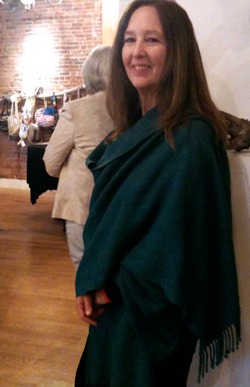Handweaver and fiber arts instructor
:|:|: My Story
I began my lifelong study of textiles at Friends World College in 1971. The College arranged weaving apprenticeships with traditional and ethnic handweavers where I lived with the weaving families, attempted to learn their language, and became immersed in their daily lives and customs. Weaving shawls on a back-strap loom in Mitla, Oaxaca was followed by shearing, hand-spinning, plant-dyeing and weaving on traditional floor looms with Berit Hjelholt in Fjerritslev, Denmark. Master Spinner/Dyer Sunniva Lonning continued my teaching in Scandinavian techniques at the Statens Laererskole in Forming in Oslo, Norway.
Becoming bored with the fabulous cleanliness of Western culture, I chose to study in India for my final 18 months. A 3-month-long study tour that introduced our small group of Western students to Indian culture and politics helped me to meet the small group of Tibetan carpet weavers that I returned to weave with for another 5 months before traveling up to Kathmandu, Nepal to weave Tibetan carpets there.
After earning my degree I have continued to study traditional textile arts in England, the Netherlands and the United States, focusing most of my energy on weaving rugs. In 2011 I purchased a 12-foot-wide Glimakra counter-balance loom, which has expanded my ability to weave large rugs and heirloom textiles. Although it looks almost industrial due to its huge size and steel cross beams, it is truly a hand-weaving loom powered only by human hands and feet. With this came the opportunity to weave with other weavers, then the acquisition of more looms and teaching others. My greatest joy now lies in weaving with others in a community of creative sharing. Teaching, creating catalognes on my Community Loom and weaving large rugs is now the focus of my work.
My Philosophy
During my college years the College President, Morris Mitchell, engaged me in a sometimes heated dialogue about the value of industrial weaving versus the “outmoded” hand-weaving methods I was studying. Morris pressed me to study mass-production weaving techniques that would clothe the largest number of people with the most efficient strategies. Although his motivation to help others was admirable, I nevertheless rebelled against the soulless nature of the mechanized textile industry and its huge, noisy and polluting infrastructure. This debate solidified my commitment to honoring and carrying forward our lasting traditions of creating textiles with natural local materials, using only human power and ideas. My work continues to be guided by the ideas I formed then – that those things made with human hands and energy are imbued with something more than just technical excellence. And these fabrics express and communicate human ideas, energy and emotion that enrich their practical value.
Every piece is woven and finished by hand, with no electrical or hydraulic power.
No two pieces are exactly alike. (Unless they are made to match in one order.)
My intentionally small workshops are creative communities of learning and support.
All custom work is carefully planned with samples, input and final approval by the client.
I am committed to working locally and with as little impact on the environment as possible.
Weaving a catalogne (rag coverlet) on the Community Loom in the old Grange Hall, Old Lyme, Connecticut.
Image thanks to Jodi MacBeth Brewer



